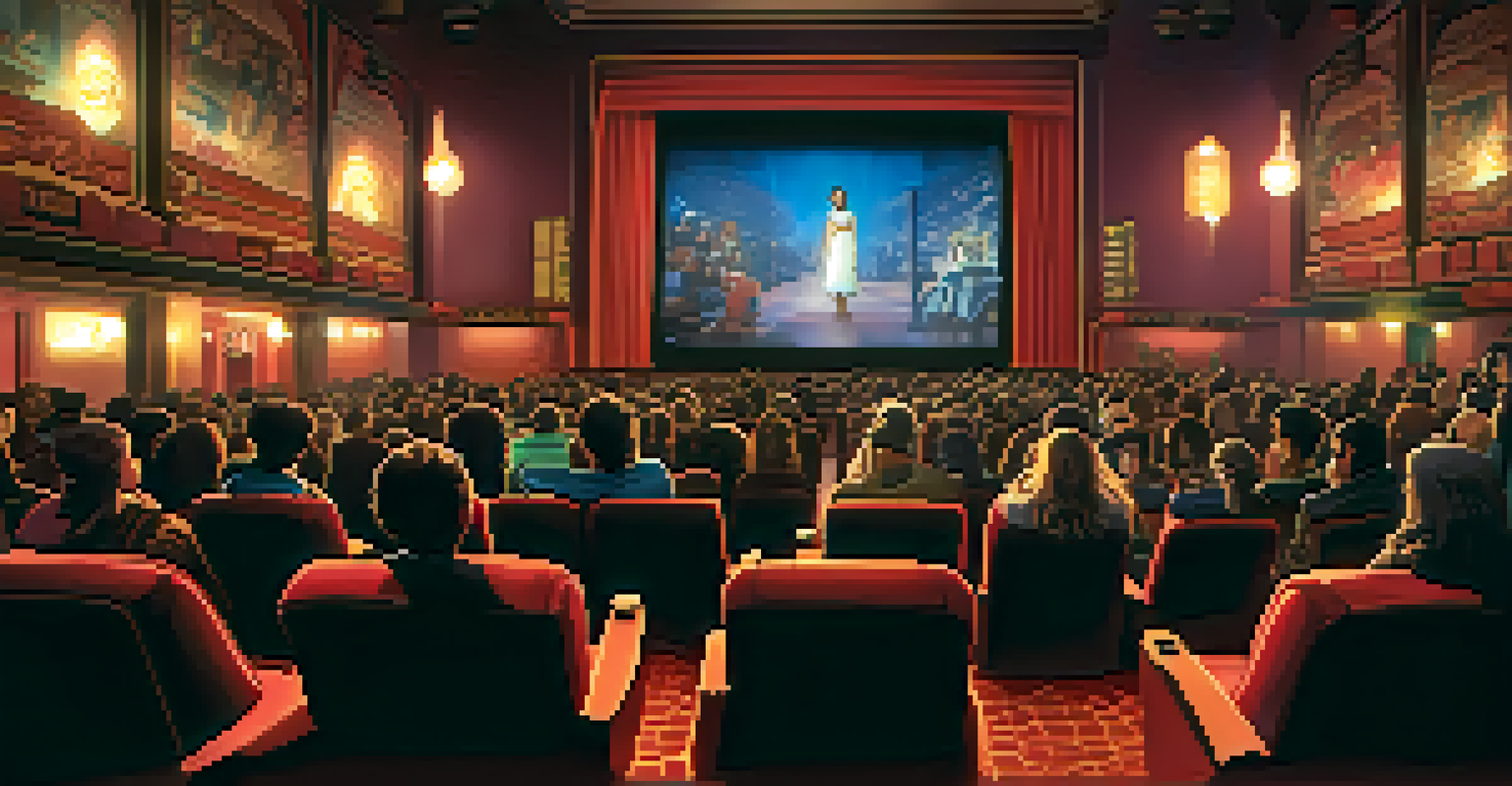Cultural Adaptation: Hollywood Remakes and Local Narratives

Understanding Cultural Adaptation in Film
Cultural adaptation in film refers to how stories are modified to resonate with different audiences. This process often involves reinterpreting characters, themes, and settings to fit local traditions and values. For instance, a movie that highlights family dynamics in one culture may shift focus to community ties in another, ensuring it speaks to local viewers.
Movies are a form of cultural dialogue, a bridge between different worlds.
At its core, cultural adaptation seeks to bridge gaps between diverse audiences while maintaining the essence of the original story. It's like a translator working to convey not just the words, but the emotions and cultural nuances behind them. This approach allows filmmakers to create works that feel authentic and relatable to their target demographic.
Hollywood, with its global reach, often leads this trend by producing remakes of successful foreign films. These remakes aim to attract wider audiences while also honoring the original’s narrative style, demonstrating a blend of creativity and cultural sensitivity.
The Power of Hollywood Remakes
Hollywood remakes serve as a powerful tool for introducing international stories to a broader audience. By reimagining a successful film from another culture, filmmakers can create a version that resonates with American audiences while highlighting the original's themes. This can lead to increased interest in the source material and even spark a cultural exchange.

For example, the American adaptation of the Japanese horror film 'The Ring' took a deeply rooted cultural fear and translated it into a narrative that American viewers found equally chilling. The remake was successful not only in box offices but also in bringing attention to the original film, showcasing how remakes can breathe new life into an existing narrative.
Cultural Adaptation in Film
Cultural adaptation modifies stories to resonate with local audiences while preserving the original's essence.
These adaptations often reflect a blending of cultures, as filmmakers navigate local tastes and preferences. In doing so, they create a dialogue between the original and adapted versions, enriching both cinematic landscapes.
Examples of Successful Cultural Adaptations
Some Hollywood remakes have achieved notable success by carefully adapting local narratives. A prime example is 'The Departed,' which is a reimagining of the Hong Kong film 'Infernal Affairs.' The American version retained the gritty undercurrents of the original while infusing it with local law enforcement nuances, making it relatable to a Western audience.
Cinema is a mirror by which we often see ourselves.
Similarly, 'The Intouchables,' a French film about an unlikely friendship, was remade as 'The Upside' in the United States. While the core story remained intact, the American version adjusted certain cultural elements, highlighting the differences in social class and race that resonate more deeply with U.S. audiences.
These adaptations showcase how filmmakers can successfully navigate cultural differences while maintaining the heart of the story. They demonstrate that stories can transcend borders when approached thoughtfully.
Challenges in Cultural Adaptation
While remaking films can be a creative endeavor, it often comes with its own set of challenges. One major hurdle is ensuring that the core themes and messages translate effectively across cultures. A joke that is considered humorous in one culture may fall flat or be offensive in another, necessitating careful consideration and sometimes significant changes.
Moreover, filmmakers must navigate the risk of cultural appropriation, where they borrow elements from another culture without proper understanding or respect. This can lead to backlash from audiences who feel that their culture is being misrepresented or exploited. Striking a balance between homage and adaptation is essential for a successful remake.
Hollywood Remakes Expand Reach
Remakes of international films allow Hollywood to introduce diverse narratives, fostering cultural exchange.
Additionally, there’s the challenge of audience expectations. Fans of the original film often have strong emotional ties to the story, and any deviation can lead to disappointment. Filmmakers need to be mindful of this while still delivering a fresh and engaging take on the narrative.
The Role of Local Narratives in Remakes
Local narratives play a crucial role in shaping the adaptations of Hollywood remakes. By incorporating culturally specific elements, filmmakers can create a product that feels authentic and relevant to the audience. This not only enhances the storytelling but also fosters a deeper connection with viewers.
For instance, when adapting a film based on a foreign culture, including local customs, language, and social dynamics can enrich the narrative. This approach allows filmmakers to honor the original story while adding layers that resonate with local audiences. It’s like seasoning a dish—adding just the right amount can elevate the whole experience.
Moreover, local narratives can offer fresh perspectives that challenge stereotypes. By showcasing diverse stories and characters, remakes can contribute to a more nuanced understanding of different cultures, promoting empathy and appreciation among viewers.
The Future of Cultural Adaptation in Film
As globalization continues to shrink boundaries, the future of cultural adaptation in film looks promising. More filmmakers are embracing the idea of blending narratives from different cultures, creating a rich tapestry of storytelling. This trend not only brings diverse stories to the forefront but also encourages collaboration between international filmmakers.
With streaming platforms gaining popularity, there's a growing appetite for varied narratives that reflect the world’s diversity. This shift opens up opportunities for Hollywood to explore stories beyond its borders, leading to innovative remakes that celebrate cultural differences rather than shy away from them.
Challenges of Cultural Sensitivity
Filmmakers face hurdles in ensuring themes translate effectively while avoiding cultural appropriation.
Ultimately, the future lies in a respectful collaboration that honors the roots of original stories while making them accessible to new audiences. This approach can lead to a new era of filmmaking that is both inclusive and reflective of our interconnected world.
Concluding Thoughts on Cultural Adaptation
Cultural adaptation through Hollywood remakes is a fascinating intersection of creativity and respect for local narratives. While the process has its challenges, it also presents an opportunity for storytelling that transcends cultural boundaries. By thoughtfully adapting stories, filmmakers can create films that resonate with a diverse audience.
As audiences continue to seek authentic narratives, the importance of cultural sensitivity in remakes cannot be overstated. It’s essential for filmmakers to approach adaptations with care, ensuring that they honor the original while making it accessible to new viewers. This balance is key to fostering appreciation and understanding among different cultures.

In the end, the true power of film lies in its ability to connect us. Through cultural adaptation, Hollywood remakes can serve as a bridge, bringing together stories that celebrate the richness of our diverse experiences.